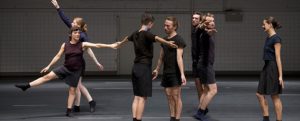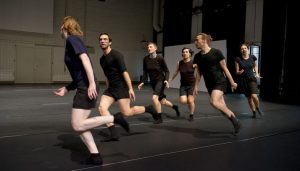Het lijkt een flauwe woordgrap: op het nieuwe festival Spring Utrecht kon een Sacre-project natuurlijk niet ontbreken. Maar het is gewoon een serieuze trend. Laurent Chetouane is niet de enige hedendaagse dansmaker die de maatschappij duidt aan de hand van complex groepsgedrag, op de grens van choreografie en improvisatie. Zie bijvoorbeeld ook recent werk van De Keersmaeker en Charmatz.
De oorspronkelijke Sacre du Printemps werd in opdracht van Diaghilev voor de Ballet Russes gemaakt. Het stuk dankt zijn faam eigenlijk vooral aan de baanbrekende ritmes en dwarse tonaliteit van Stravinsky. De choreografie van Nijinski, die volgende week 100 jaar geleden zijn première had in Parijs, werd maar 10 keer opgevoerd. Het is de ballet-versie van Massine uit 1920, die als basis diende voor beroemde her-intepretaties van choreografen als Maurice Béjart en Pina Bausch. Bij Béjart wordt niet alleen een meisje geofferd maar een koppel, en Bausch maakte van de Sacre een verwijt aan de mannenmaatschappij: vrouwen offeren. In dit jubeljaar gaat Chetouane een stap verder. Hij verzet zich tegen het offeren van mensenlevens überhaupt.

Haast verlegen betreden de zeven dansers het stille, lege toneel. Dat wordt zo een plek van verwachtingen en interpretaties: alles kan iets worden, maar ook ieder moment weer te niet worden gedaan. In onderlinge verstandhouding (blikken worden gewisseld, afstand wordt gemeten) en met een paar abstracte vegen kleurrijke schminck op het gezicht, zetten de dansers hun eerste stappen, delen gestes uit, naar elkaar en naar het publiek. Een huppeltje hier en daar versnelt, verdubbelt het spel met verhoudingen in ruimte en tijd.
De dansers beschrijven zo allerlei mogelijke verhoudingen. Het lijkt op uit de hand gelopen kinderspel. Binnen afzienbare tijd draait de groep op volle toeren, geeft zich over, en duikt steeds dieper in een soort opgewondenheid, zoals de natuur die nu eenmaal in het voorjaar bestelt: bals. Gefladder, gewapper, gedraai, gekir, gekoer, geëxalteerd, en dus ook exotisch en vreemd voor wie niet mee doet. Tot zover het begrijpelijke deel van de kwestie. Minder voor de hand liggend is het voorstel om bij dit balsen iemand de dood te laten vinden.
Chetouane, die reeds een flink oeuvre op zijn naam heeft staan als regisseur van sleutelteksten uit het Duitse toneel, maakt sinds een aantal jaren ook dans, met als voorlopig hoogtepunt in 2011 Horizon(s). Zijn vaste componist en bassist van de band Selig, Leo Smidthals, componeerde een ‘voor’ en een ‘na’ bij de twee aktes van Stravinsky. Sober gesteld, ritmisch uitdagend, met hier en daar een accent van een solerende fluit of viool, bouwt het stuk langzaam op, tot de Sacre zelf klinkt. De flirtations beginnen meer en meer op een gezamenlijk ritueel te lijken. Een religieuze verwijzing verandert de zaak van elementaire uitwisseling tussen mensen naar maatschappelijke structuur. De groep als geheel wordt steeds dominanter en spuugt bij voortduring nieuwe kandidaten uit die zich steevast richting publiek begeven, maar om wat te beginnen? Steeds opnieuw lijkt het aanbod om te delen tevergeefs. De voortdurende opwinding lost ook niet op in een hoogtepunt of debacle op scène. Steeds meer begint de opwinding zonder offer, zonder plot, een handelen zonder doel te worden.
Voor mij, op de eerste rij, neemt een dagbladcritica reeds het Spring-programmaboekje door. Iets verderop bediscussieert een mee-dirigerende bezoekster de voorstelling met haar duidelijk geirriteerde partner. Ik vergaap mij aan de op renaissancistische fresco’s lijkende beelden die her en der ontstaan, opgebouwd uit kleine gestes en subtiele bewegingen, humanistisch. Eindeloos veel details lees ik in de manier waarop de zeven dansers ieder hun weg gaan, ondanks het groepsgedoe of juister gezegd, in wisselwerking daarmee. Verwijzingen naar wat ooit misschien vanzelfsprekend was, verheven rol en mythische proporties, lijken nu een ridicuul verhaal, dat desalniettemin nog steeds slachtoffers eist. Of zijn het clowns, carnavalsvierders, is het uitgelaten naïviteit, toneel op toneel om het kwaad te oefenen, niet om het te legitimeren?

Op de dag dat ik dit schrijf, circuleren over de hele wereld beelden van een jongen met bloed aan zijn handen en messen. Hij laat zich filmen door een voorbijganger. Later loopt hij samen met zijn maat schietend richting de politie. Hij zoekt vergelding, voor eerdere slachtoffers. Een paar dagen eerder, na afloop van de voorstelling tijdens Spring, lichtte Chetouane toe: dat hij moe is van conflict, verveeld zelfs, geen offers meer, het liefst zelfs geen contract, want ook dat sluit mensen uit. Maar wat is het verblijf in een groep waard, als deze het recht niet heeft om mensen die amok maken buiten te zetten of niet toe te laten, zoals de rechtsfilosoof Gijs van Oenen zei tijdens een discussie op het festival met de gehandicapte danseres Vicky Malin en de uitgeprocedeerde asielzoeker Yunes Omar? De samenleving als een open groep, zonder contract over in- en uitsluiting, of over wie geweld mag gebruiken en wie niet? Om elkaar heen blijven dansen, tot je er bij neervalt? Het mag in politiek opzicht een tandeloze tijger lijken, een utopie – maar de voorstelling is er niet minder om, in tegendeel. Het blijft een goede vraag, door Chetouane op een even subtiele als confronterende manier gesteld: waarom hebben we dat ge-offer nodig? Waarom moeten er steeds opnieuw mensen het onderspit delven, stomweg om een zekere orde te handhaven?
